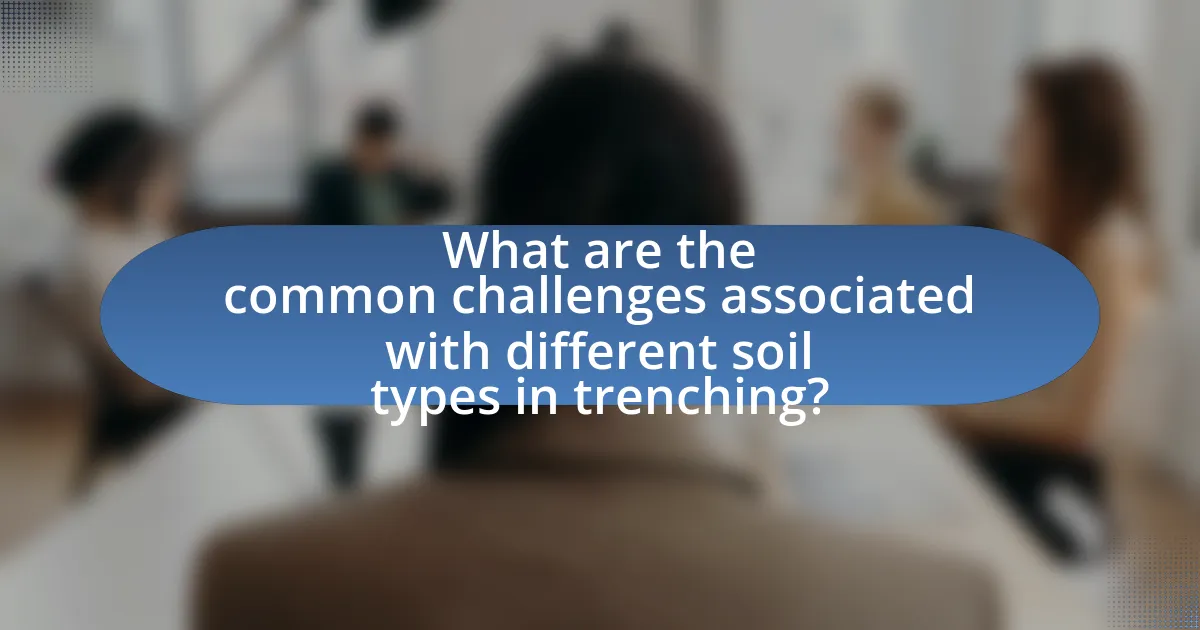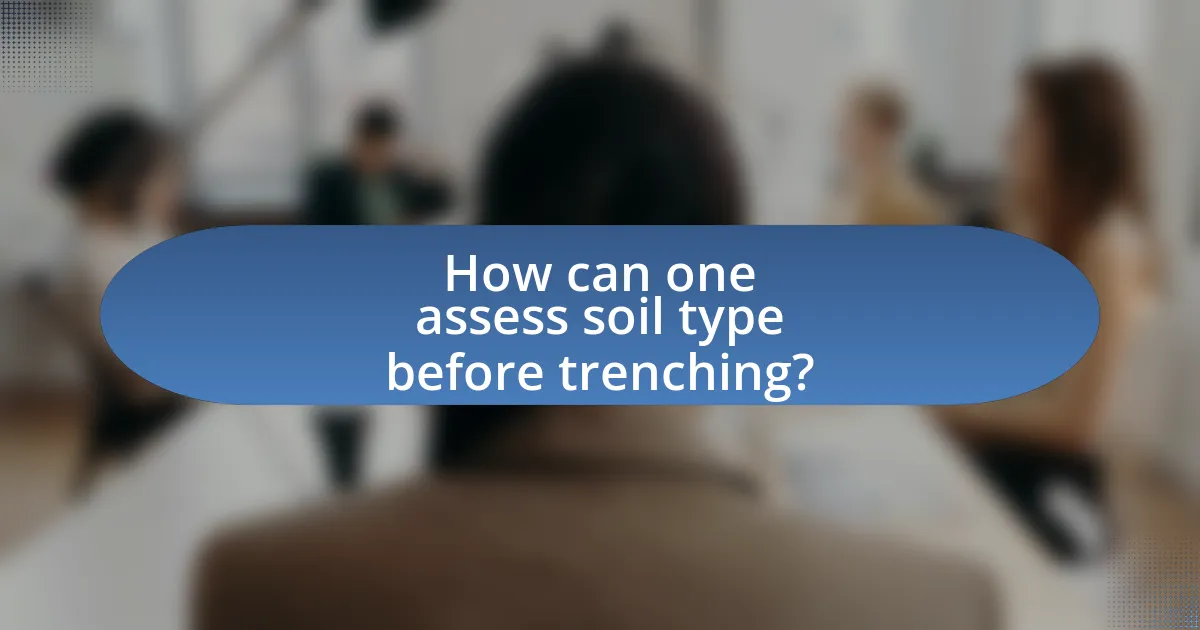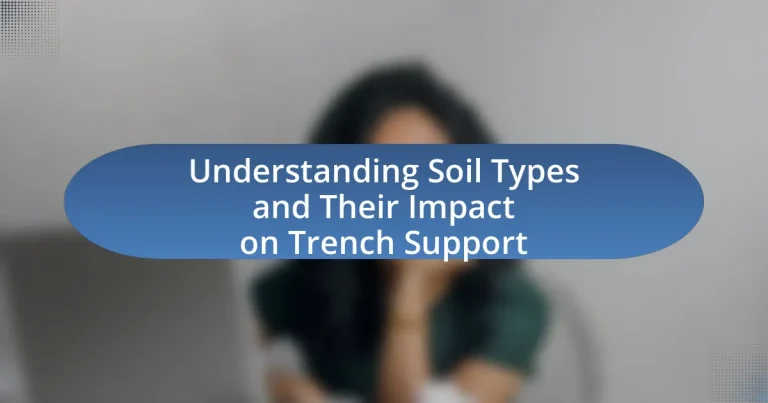The article focuses on understanding various soil types and their significant impact on trench support. It categorizes soils into sandy, clay, silt, loamy, and peaty, detailing their unique characteristics such as drainage capabilities, nutrient retention, and stability under load. The discussion emphasizes how these properties influence trench stability, the risks of collapse, and the importance of proper soil assessment for safe excavation practices. Additionally, it outlines best practices for trench shoring and mitigation strategies to enhance safety based on soil composition, while also addressing the limitations of current soil testing methods and the role of technology in soil evaluation.

What are the different types of soil and their characteristics?
The different types of soil include sandy, clay, silt, loamy, and peaty soils, each with distinct characteristics. Sandy soil has large particles, excellent drainage, and low nutrient retention, making it less fertile. Clay soil consists of tiny particles that compact easily, leading to poor drainage but high nutrient retention. Silt soil has medium-sized particles, retains moisture well, and is fertile, often found in river valleys. Loamy soil is a balanced mixture of sand, silt, and clay, providing good drainage and fertility, ideal for agriculture. Peaty soil is rich in organic matter, retains moisture, and is typically found in wetlands, but can be acidic and low in nutrients. These characteristics influence soil behavior, affecting trench support and construction practices.
How do soil types influence trench stability?
Soil types significantly influence trench stability by affecting the soil’s cohesion, friction angle, and overall load-bearing capacity. Cohesive soils, such as clay, tend to retain water and can become unstable when saturated, leading to increased risk of trench collapse. In contrast, granular soils, like sand and gravel, provide better drainage and typically have higher friction angles, which enhances stability. Research indicates that trenches in cohesive soils require more support systems, such as shoring or bracing, compared to those in granular soils, which can often stand unsupported for short periods. The stability of trenches is thus directly correlated with the soil type, as evidenced by engineering guidelines that recommend specific excavation practices based on soil classification.
What are the properties of cohesive soils?
Cohesive soils are characterized by their fine particle size, high plasticity, and ability to retain water. These properties result in cohesive soils having significant shear strength when saturated, which is crucial for stability in trench support applications. The plasticity index of cohesive soils, which measures the range of moisture content over which the soil remains plastic, typically ranges from 10 to 40, indicating their ability to deform without cracking. Additionally, cohesive soils exhibit high compressibility, meaning they can undergo significant volume changes when subjected to loading or moisture variations. These properties make cohesive soils essential considerations in engineering and construction, particularly in trench support systems where soil stability is paramount.
How do granular soils behave under load?
Granular soils exhibit a behavior characterized by increased strength and stability under load due to their ability to dissipate stress effectively. When subjected to load, granular soils, such as sand and gravel, experience a rearrangement of particles that allows for the transfer of weight through inter-particle friction and contact forces. This behavior is supported by the fact that granular soils have high permeability, enabling rapid drainage of pore water pressure, which further enhances their load-bearing capacity. Studies have shown that the angle of internal friction in granular soils typically ranges from 30 to 45 degrees, indicating their ability to support significant loads without excessive deformation.
Why is understanding soil composition important for trench support?
Understanding soil composition is crucial for trench support because it directly influences the stability and safety of excavations. Different soil types, such as clay, sand, and silt, have varying load-bearing capacities and drainage characteristics, which affect how trenches can be supported. For instance, cohesive soils like clay can retain water and become unstable when saturated, while granular soils like sand may shift easily under load. According to the Occupational Safety and Health Administration (OSHA), improper assessment of soil conditions can lead to trench collapses, which are a leading cause of fatalities in excavation work. Therefore, understanding soil composition allows for the implementation of appropriate support systems, such as shoring or trench boxes, to mitigate risks and ensure worker safety.
What role does moisture content play in soil behavior?
Moisture content significantly influences soil behavior by affecting its strength, compressibility, and permeability. When soil moisture increases, it can lead to reduced cohesion and increased plasticity, which may result in instability, particularly in clay soils. Conversely, lower moisture content typically enhances soil strength and stability, making it more suitable for construction and trench support. Research indicates that optimal moisture levels can improve the load-bearing capacity of soils, as demonstrated in studies like “The Effect of Water Content on Soil Strength” published in the Journal of Geotechnical Engineering, which found that cohesionless soils exhibit peak strength at specific moisture levels.
How does soil density affect trench excavation?
Soil density significantly affects trench excavation by influencing the stability and ease of excavation. Higher soil density typically results in increased resistance to excavation efforts, making it more challenging to dig and requiring more powerful machinery or tools. Conversely, lower soil density allows for easier excavation but may lead to instability in trench walls, increasing the risk of collapse. According to the American Society of Civil Engineers, soil density directly correlates with the soil’s cohesion and friction angle, which are critical factors in determining the safety and feasibility of trenching operations.

What are the common challenges associated with different soil types in trenching?
Common challenges associated with different soil types in trenching include instability, water retention, and compaction issues. For instance, sandy soils often lead to trench collapse due to their loose structure, while clay soils can retain water, increasing the risk of flooding and making excavation difficult. Additionally, rocky soils present challenges in terms of equipment wear and increased labor costs due to the need for specialized tools. These challenges are well-documented in construction safety guidelines, which emphasize the importance of understanding soil characteristics to mitigate risks during trenching operations.
How can soil type lead to trench collapse?
Soil type can lead to trench collapse due to its inherent properties, such as cohesion, density, and moisture content. Cohesive soils, like clay, can retain water and become unstable when saturated, increasing the risk of collapse. Conversely, granular soils, such as sand, lack cohesion and can shift easily, especially when disturbed. According to the Occupational Safety and Health Administration (OSHA), trenches deeper than five feet require protective systems, as the type of soil significantly influences the stability and safety of the trench.
What are the signs of potential trench failure in various soils?
Signs of potential trench failure in various soils include soil movement, cracking, bulging, and water accumulation. Soil movement indicates instability, often seen in cohesive soils like clay, where changes in moisture content can lead to failure. Cracking occurs when the soil dries out or is disturbed, particularly in sandy soils, signaling a loss of structural integrity. Bulging at the trench walls suggests excessive lateral pressure, which can happen in loose or saturated soils. Water accumulation in or around the trench can weaken soil cohesion, especially in silty or clayey soils, increasing the risk of collapse. These signs are critical for assessing trench safety and preventing accidents.
How do different soil types respond to excavation techniques?
Different soil types respond uniquely to excavation techniques due to their physical and chemical properties. For instance, sandy soils tend to drain quickly and are less cohesive, making them easier to excavate but more prone to collapse without proper support. In contrast, clay soils are dense and cohesive, requiring more effort to excavate and often necessitating shoring to prevent cave-ins. Loamy soils, which are a mix of sand, silt, and clay, provide a balance, allowing for manageable excavation while still needing some support to maintain stability. These responses are critical for ensuring safety and efficiency in excavation projects, as highlighted in studies on soil mechanics and excavation safety protocols.
What mitigation strategies can be employed for trench support?
Mitigation strategies for trench support include the use of shoring systems, trench boxes, and proper soil stabilization techniques. Shoring systems, such as hydraulic or mechanical shores, provide lateral support to prevent soil collapse, while trench boxes create a safe working environment by protecting workers from cave-ins. Additionally, soil stabilization techniques, such as the use of chemical additives or compaction methods, enhance soil strength and reduce the risk of failure. According to the Occupational Safety and Health Administration (OSHA), implementing these strategies significantly decreases the likelihood of trench-related accidents, highlighting their effectiveness in ensuring safety during excavation activities.
How can soil stabilization techniques improve trench safety?
Soil stabilization techniques improve trench safety by enhancing the load-bearing capacity and reducing the risk of soil collapse. These techniques, such as the use of chemical additives, mechanical compaction, or geosynthetics, effectively bind soil particles together, thereby increasing stability. For instance, a study published in the Journal of Geotechnical and Geoenvironmental Engineering found that chemical stabilization can reduce soil plasticity and increase shear strength, which directly contributes to safer trench conditions. By minimizing soil movement and preventing cave-ins, these methods significantly lower the likelihood of accidents and injuries associated with trench work.
What are the best practices for trench shoring in various soil conditions?
The best practices for trench shoring in various soil conditions include selecting appropriate shoring systems based on soil type, conducting soil analysis, and adhering to safety regulations. For cohesive soils, such as clay, using hydraulic shoring or trench boxes is effective, as these systems provide stability and prevent collapse. In granular soils, like sand or gravel, trench boxes or sheet piling are recommended to resist lateral pressure. Additionally, regular inspections and monitoring of soil conditions are crucial, as soil can change due to weather or excavation activities. According to OSHA regulations, proper shoring techniques must be implemented to ensure worker safety, emphasizing the importance of following established guidelines for trench safety.

How can one assess soil type before trenching?
To assess soil type before trenching, one can conduct a soil test, which involves collecting soil samples from the trench area and analyzing them for texture, composition, and moisture content. This method provides accurate information about the soil’s physical properties, such as whether it is sandy, clayey, or loamy, which directly influences trench stability and support requirements. Soil tests can be performed using simple field methods, like the jar test for texture, or through laboratory analysis for more detailed results, ensuring that the assessment is reliable and relevant for trenching activities.
What methods are used for soil testing and analysis?
Soil testing and analysis methods include physical, chemical, and biological testing techniques. Physical methods assess soil texture, structure, and moisture content through procedures like sieve analysis and hydrometer tests. Chemical methods evaluate soil pH, nutrient levels, and contaminants using techniques such as titration and spectrophotometry. Biological methods analyze microbial activity and organic matter content through assays like respiration tests and enzyme activity measurements. These methods are essential for determining soil health and suitability for construction projects, including trench support, as they provide critical data on soil stability and load-bearing capacity.
How do field tests differ from laboratory tests in soil assessment?
Field tests differ from laboratory tests in soil assessment primarily in their execution environment and the type of data they provide. Field tests are conducted on-site, allowing for real-time evaluation of soil conditions, which can include factors like moisture content, compaction, and in-situ strength. In contrast, laboratory tests involve collecting soil samples and analyzing them under controlled conditions, providing detailed information on soil properties such as grain size distribution, plasticity, and chemical composition. The results from field tests reflect the actual conditions of the soil at the location, while laboratory tests offer a more comprehensive analysis of soil characteristics that may not be observable in the field.
What indicators should be observed during a soil survey?
During a soil survey, key indicators to observe include soil texture, moisture content, pH levels, organic matter content, and compaction. Soil texture affects drainage and nutrient retention, while moisture content indicates the soil’s ability to support plant life and structural integrity. pH levels influence nutrient availability, organic matter content contributes to soil fertility, and compaction affects root growth and water infiltration. These indicators are essential for assessing soil suitability for various applications, including trench support, as they directly impact stability and load-bearing capacity.
What tools and equipment are essential for soil evaluation?
Essential tools and equipment for soil evaluation include soil augers, soil probes, trowels, and pH meters. Soil augers are used to collect soil samples from various depths, allowing for analysis of soil composition and structure. Soil probes facilitate the extraction of soil cores for testing moisture content and density. Trowels assist in examining soil texture and layering, while pH meters measure soil acidity, which is crucial for understanding nutrient availability. These tools collectively enable accurate assessment of soil properties, which is vital for determining trench support requirements.
How can technology enhance soil type identification?
Technology enhances soil type identification through advanced methods such as remote sensing, soil sensors, and machine learning algorithms. Remote sensing utilizes satellite imagery and aerial photography to analyze soil characteristics over large areas, providing data on moisture levels, organic matter, and vegetation cover. Soil sensors, which can be deployed in the field, measure parameters like pH, electrical conductivity, and moisture content in real-time, allowing for precise soil assessments. Machine learning algorithms process this data to identify patterns and classify soil types more accurately than traditional methods. Studies have shown that these technologies can improve soil classification accuracy by up to 30%, facilitating better decision-making in agricultural practices and construction projects.
What are the limitations of current soil testing methods?
Current soil testing methods have several limitations, including their inability to provide a comprehensive understanding of soil variability and their reliance on discrete sampling. These methods often assess only a limited number of parameters, such as pH and nutrient levels, which may not capture the full complexity of soil conditions. Additionally, traditional testing can be time-consuming and may not reflect real-time changes in soil properties due to environmental factors. For instance, a study published in the Journal of Soil Science highlighted that conventional tests often overlook the spatial heterogeneity of soil, leading to inaccurate assessments for applications like trench support.
What are the best practices for ensuring trench safety based on soil type?
The best practices for ensuring trench safety based on soil type include conducting a thorough soil analysis, implementing appropriate shoring techniques, and adhering to safety regulations. Soil analysis helps identify the type of soil, such as cohesive or granular, which influences trench stability. For cohesive soils, such as clay, sloping the trench walls at a 1:1 ratio is often effective, while granular soils, like sand, may require more robust shoring systems, such as trench boxes or hydraulic shores, to prevent collapse. Compliance with OSHA regulations, which mandate specific requirements based on soil classification, further reinforces safety measures. These practices are supported by data indicating that proper trench safety measures can reduce accidents by up to 90%.


